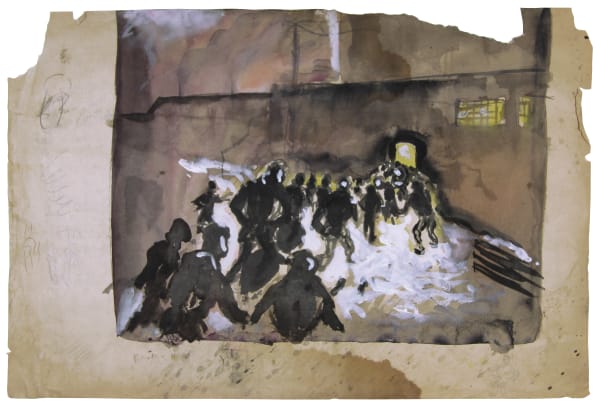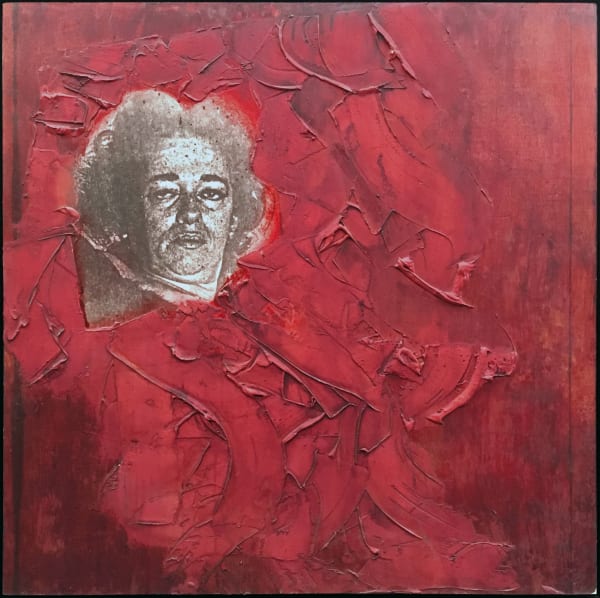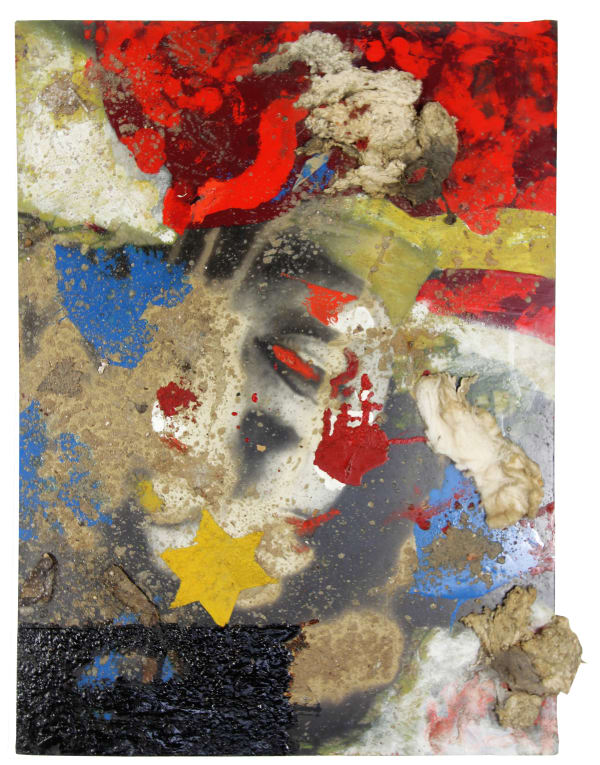Boris Lurie: 100 Years
Westwood Gallery NYC, in collaboration with the Boris Lurie Art Foundation, presents Boris Lurie: 100 Years, a landmark exhibition honoring the centennial of the influential artist and co-founder of the NO!art movement. Curated by James Cavello, the exhibition brings together more than 30 paintings, collages, and works on paper from 1945–1972, tracing Lurie’s uncompromising artistic vision from his early postwar drawings to his groundbreaking collages and NO!art paintings.
Opening on July 18, 2024—the 100th anniversary of Lurie’s birth—the show marks the artist’s third solo exhibition at Westwood Gallery NYC and includes rarely seen works, such as the monumental Memo to the U.S. [Hairdos] (1963), exhibited in the United States for the first time. Boris Lurie: 100 Years offers a powerful meditation on survival, resistance, and hope, reaffirming the enduring relevance of his radical legacy.
-
 Boris Lurie, Untitled, circa 1945-49
Boris Lurie, Untitled, circa 1945-49 -
 Boris Lurie, Untitled, circa 1946
Boris Lurie, Untitled, circa 1946 -
 Boris Lurie, Untitled, circa 1946
Boris Lurie, Untitled, circa 1946 -
 Boris Lurie, Untitled, circa 1946
Boris Lurie, Untitled, circa 1946
-
 Boris Lurie, Untitled, circa 1946
Boris Lurie, Untitled, circa 1946 -
 Boris Lurie, Untitled, circa 1946-49
Boris Lurie, Untitled, circa 1946-49 -
 Boris Lurie, Untitled, 1949
Boris Lurie, Untitled, 1949 -
 Boris Lurie, Untitled, circa 1946-55
Boris Lurie, Untitled, circa 1946-55
-
 Boris Lurie, Three Women, 1949
Boris Lurie, Three Women, 1949 -
 Boris Lurie, Burlesque Dancer Holding Breasts, 1951
Boris Lurie, Burlesque Dancer Holding Breasts, 1951 -
 Boris Lurie, Women on Rooftop, 1951
Boris Lurie, Women on Rooftop, 1951 -
 Boris Lurie, Untitled (Three Figures), 1950
Boris Lurie, Untitled (Three Figures), 1950
-
 Boris Lurie, Untitled, circa 1949-52
Boris Lurie, Untitled, circa 1949-52 -
 Boris Lurie, Untitled, 1950
Boris Lurie, Untitled, 1950 -
 Boris Lurie, Untitled, 1950
Boris Lurie, Untitled, 1950 -
 Boris Lurie, Untitled, circa 1950
Boris Lurie, Untitled, circa 1950
-
 Boris Lurie, Untitled, 1950
Boris Lurie, Untitled, 1950 -
 Boris Lurie, Untitled, circa 1950-55
Boris Lurie, Untitled, circa 1950-55 -
 Boris Lurie, Untitled, circa 1950-55
Boris Lurie, Untitled, circa 1950-55 -
 Boris Lurie, Untitled, 1950s
Boris Lurie, Untitled, 1950s
-
 Boris Lurie, Untitled, 1950s
Boris Lurie, Untitled, 1950s -
 Boris Lurie, Untitled, 1953
Boris Lurie, Untitled, 1953 -
 Boris Lurie, Untitled, circa 1954
Boris Lurie, Untitled, circa 1954 -
 Boris Lurie, Dismembered Woman, 1955
Boris Lurie, Dismembered Woman, 1955
-
 Boris Lurie, Untitled, 1955
Boris Lurie, Untitled, 1955 -
 Boris Lurie, Untitled, 1955
Boris Lurie, Untitled, 1955 -
 Boris Lurie, Untitled (Dance Hall Series), 1955
Boris Lurie, Untitled (Dance Hall Series), 1955 -
 Boris Lurie, Dance Hall Figures, 1956
Boris Lurie, Dance Hall Figures, 1956
WESTWOOD GALLERY NYC in collaboration with the Boris Lurie Art Foundation presents Boris Lurie: 100 Years, curated by James Cavello. The anniversary exhibition, the artist’s third solo exhibition with the gallery, will include over 30 paintings, collages, and works on paper from 1945-1972 by Boris Lurie (1924-2008), co-founder of the NO!art movement. The exhibition will open on July 18th, the 100th anniversary of Boris Lurie's birth, and will be on view through July 27, 2024.
When looking at the artistic legacy of Boris Lurie, his artworks are symbols of survival, activism, freedom, and most importantly, hope.
Boris Lurie began his artistic journey in Latvia in 1930 at the age of six, when his artistic abilities were first noted by his mother’s cousin who was a practicing commercial artist. Lurie’s first self-described masterpiece was a nude he painted in 1937 at thirteen years old, and he continued to create until 1941 when German troops entered Latvia. On October 25, Boris and his family were forced to relocate to The Riga ghetto, and on November 27, Boris and his father Ilja were brought to a labor camp, leaving all his paintings behind. Lurie wouldn’t paint again until after he and his father were liberated from Buchenwald in April 1945 and after their emigration to the United States in 1946.
His first series in New York reflected his experiences during the war. Until 1948, Lurie worked privately on these drawings and watercolors, which were only exhibited after his death. Influenced by the energy of New York City and the advent of Abstract Expressionism, Pop Art, and Conceptual Art, Lurie created distinct bodies of work: the ‘Dismembered Women,’ the ‘Dance Hall’ works, ‘NO!art collages,’ the ‘Adieu Amerique’ series, and his 1970s ‘NO!art paintings,’ as well as additional smaller series of pinups and altered photos.
The exhibition includes works on paper from across his artistic oeuvre curated with key larger paintings from each series, including the monumental 16-foot Memo to the U.S. [Hairdos] (1963) never-before-exhibited in the United States. In the majority of the works on view, Lurie contends with common themes such as consumerism, imperialism, sexism, and war. However, the included works suggest a softer side to the artist. Although born from darker memories, Women on Rooftop (1951) and Untitled [Three Figures] (1950) are rendered as expressive, nude forms that emphasize the organic beauty of the human body recalling Lurie’s first self-described masterpiece years before the war. Other works from his War Series are viewed akin to historic record; rendered in black and white ink and saturated pastels, they present snapshots from the not-so-distant past.
Despite the horrors that Lurie endured during his life, his artworks have taken on a renewed sense of hope. They depict pain, not as suffering, but as healing symbols of survival and the perseverance of humanity.
----
Boris Lurie (1924-2008)was born in Leningrad, Russia, and grew up in Riga, Latvia. At the age of sixteen, he was taken prisoner by the Nazis and imprisoned for a period of four years at Buchenwald and other concentration camps. After his liberation, Lurie remained in Germany for a year and worked for the U.S. Army Counter Intelligence Corps. He moved to New York City in 1946 and began his art career there. From 1954 to 1955 he lived and worked in Paris. During his lifetime, Lurie’s NO!art was largely rejected by art critics, museums, and collectors, and has only now received renewed interest due to the work of the Boris Lurie Art Foundation.
Boris Lurie’s artwork is exhibited internationally and has been included in group exhibitions at the Museum of Modern Art, New York (NY), Grey Art Museum, New York (NY), Jewish Museum, New York (NY), Prada Foundation, Venice (Italy). Recently, Boris Lurie has had solo exhibitions at Museo Judio de Buenos Aires (Argentina), The Jewish Museum of São Paulo (Brazil), Ludwig Museum, Budapest (Hungary), Museo Nacional de las Culturas del Mundo, Mexico City (Mexico), Museo De Art Contemporáneo, Santiago (Chile), Museum of Jewish Heritage, New York (NY), and many others.
Lurie is currently on view during the Venice Biennale in the solo exhibition “Boris Lurie: Life With The Dead” at Scuola Grande San Giovanni Evangelista di Venezia, Spazio Espositivo Badoer through November 24. He is also included in “Americans in Paris: Artists Working in Postwar France, 1946-1962” at the Grey Art Museum at New York University through July 20.
The Boris Lurie Art Foundation is dedicated to preserving and exhibiting the artwork of Boris Lurie and NO!art artists.
Curator James Cavello is the President and co-owner of Westwood Gallery NYC. He has curated over 300 exhibitions including in the gallery and globally. Cavello has curated two previous exhibitions for Boris Lurie at Westwood Gallery NYC. “Boris Lurie: NO!art, Early Work, 1946-89” in 2010, the first New York exhibition after Lurie’s death, and “Boris Lurie: Life After Death” in 2017, which was accompanied by a catalogue of the same name with essays by James Cavello, Margarite Almeida, and art critic Robert C. Morgan.











































